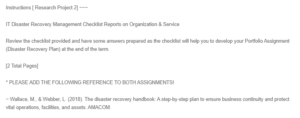IT Disaster Recovery Management Checklist Reports on Organization and Service
The service management domain is where the organization focuses more on attaining Service Level Agreements (SLAs) and the Service Catalog Targets. These targets are not only contractual obligations but are imperative in ensuring that services consistently meet the guarantees made to valued customers. Key priorities include service availability and usability. Loss of time or unavailability can drastically affect operations and customer satisfaction. An organization must implement scalable solutions and load-balancing mechanisms to deal with the situation of doubling throughput in service so that it enables effective service delivery at times of peak demand.
Service Checklist
The commitment to upholding documented Service Desk procedures remains unshaken. These practices are the key drivers behind effective incident response and customer support, facilitating unbiased and prompt resolution of issues. When incidents occur, organizations often provide emergency services essential to communities’ well-being. Therefore, ensuring telephone services are available when needed is critical. Assessing whether material outsourcing agreements are adequate forms part of the strategy for service resilience. This helps provide proactive actions before the problem escalates, as there are alert mechanisms that detect abnormal service activity (Wallace & Webber, 2018).
To ensure that the organization meets service quality standards, service performance monitoring against SLAs is a continual process. To identify areas where improvements can be made, ITSLA’s effectiveness is reviewed regularly. The ability to interoperate with technical hazmat equipment is an essential aspect of disaster recovery planning. Firstly, service level management is a crucial function responsible for defining, negotiating, and maintaining SLAs. Continuous efforts towards ensuring that the service meets requirements and expectations are guided by customer satisfaction as a core business value. Quality assurance practices are often standard at the Service Desk, resulting in consistent service quality.
Effective communication and collaboration are facilitated by establishing primary contacts with critical vendors, suppliers, and service providers. All necessary IT systems, applications, and services are identified, sustainably supported, and maintained within operations (Wallace & Webber, 2018). This can affect the capacity to provide good quality services and thus the need to promptly address the high abandon rate in the Service Desk. There will be no compromise concerning maintaining customer satisfaction as far as the follow-up on service breaches is concerned. Almost all of these performance targets are met; hence, it becomes easy to monitor their percentages. During the transition period, the Service Desk facilitates a smooth transition while minimizing disruptions. Essentially, tests should be conducted on factors that may hinder the restoration of services after the first call or interaction, which should be addressed in an anticipatory manner.
Organizational Checklist
Refocusing on organizational aspects of disaster recovery management, the organization starts by assessing if a hybrid cloud implementation can scale up as needs grow. In this journey, it is vital to consider the scalability of hybrid cloud infrastructure so that it can easily change in line with evolving requirements. The corporation’s corporative knowledge and intellectual capital contribute to resilience and adaptability (Sahebjamnia et al., 2015). By leveraging this knowledge, informed decisions can be made to navigate complex challenges effectively. IT Service Management (ITSM) tools are integral to operations because they streamline processes, improve efficiency, and enhance service delivery. These tools enable effective monitoring, managing, and optimizing of IT services. The most likely benefit expected from this will be increased operational efficiency. The company aims to enhance overall efficiency and productivity by leveraging ITSM tools, streamlining processes, and fostering a culture of continuous improvement.
A contractor should provide training tailored to meet the organization’s needs. This training is essential for ensuring the team is well-prepared to use new technology and processes appropriately. Financial organizations often rely on regulatory guidance for compliance and risk mitigation purposes. Understanding and adhering to pertinent regulatory guidance is essential in operating a business entity. To minimize vulnerabilities, organizations demonstrate a strong commitment to a comprehensive mitigation program, including risk assessment and contingency planning, among others. Procurement is critical; hence, materials needed to produce products or services should be carefully selected from appropriate sources. This procurement decision directly impacts supply chain resilience and continuity of operation (Sahebjamnia et al., 2015).
Assurances provided by organizations are essential in building trust and confidence with stakeholders. Ensuring clear, transparent communication helps stakeholders know that the organization has prepared itself for any disruption. All hardware, software, and materials to be bought in connection with the Globe Modernization project are thoroughly evaluated and selected depending on how well they align with the project goals and how well they suit the organization’s needs. With roster procedures, a consultative process with staff and unions ensures that workforce management remains mutually beneficial and collaborative. For a quick response to critical incidents, having an on-call or first responders group within the organization is important so that appropriate personnel can be promptly mobilized.
References
Sahebjamnia, N., Torabi, S. A., & Mansouri, S. A. (2015). Integrated business continuity and disaster recovery planning: Towards organizational resilience. European journal of operational research, 242(1), 261-273.
Wallace, M., & Webber, L. (2018). The disaster recovery handbook: A step-by-step plan to ensure business continuity and protect vital operations, facilities, and assets. AMACOM.
ORDER A PLAGIARISM-FREE PAPER HERE
We’ll write everything from scratch
Question

IT Disaster Recovery Management Checklist Reports
Instructions [ Research Project 2] ~~~
IT Disaster Recovery Management Checklist Reports on Organization & Service
Review the checklist provided and have some answers prepared as the checklist will help you to develop your Portfolio Assignment (Disaster Recovery Plan) at the end of the term.
[2 Total Pages]
* PLEASE ADD THE FOLLOWING REFERENCE TO BOTH ASSIGNMENTS!
~ Wallace, M., & Webber, L. (2018). The disaster recovery handbook: A step-by-step plan to ensure business continuity and protect vital operations, facilities, and assets. AMACOM.

